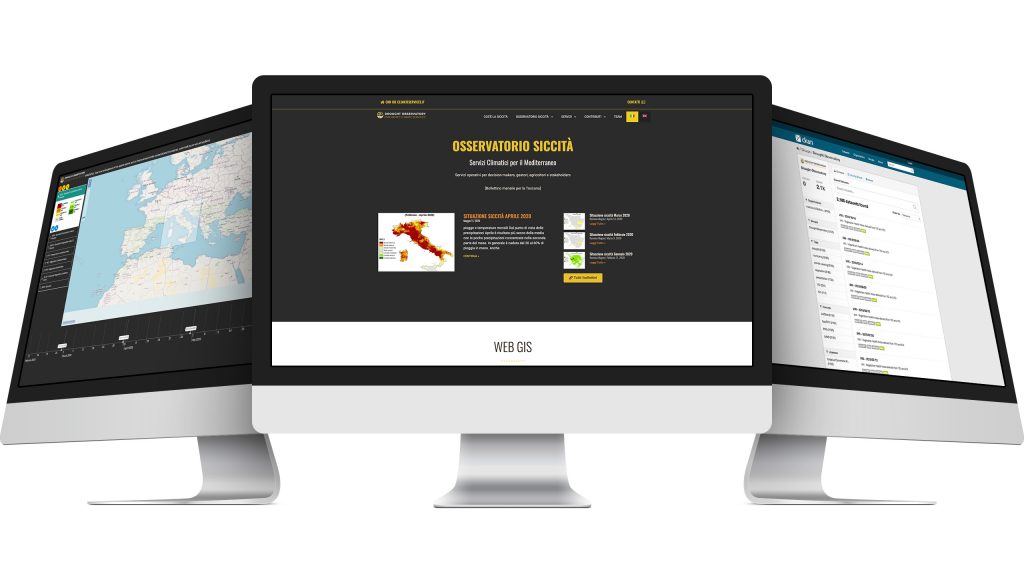Coping with a complex phenomenon
//Category / Services
// Tags / drought
Heat waves and droughts have important and increasing repercussions on physical, chemical and biological systems, and on some socio-economical aspects such as health, agriculture, natural ecosystems and tourism.
Drought monitoring and forecasting system
The system provides a semi-automatic, detailed, timely and comprehensive operational service. This service, initially developed for Tuscany Region, supports decision makers, water authorities, researchers and general stakeholders
Meteorological stations network, satellite images and models are integrated through an open source and interoperable SDI (Spatial Data Infrastructure) based on PostgreSQL/PostGIS to produce vegetation and precipitation indices to follow the occurrence and evolution of a drought event.
The system is based on a monitoring component and on a forecasting ones. It uses two type of indices:

Through CKAN and GeoServer, a complete catalogue to publish data and metadata in several formats and standard protocols. Spatial data can be integrated and reused by any third-party client application.
The SDI set up for the Observatory allows the dissemination of comprehensive, up-to-date information, customisable for different end users and delivered through different channels.

A complete catalogue (CKAN and GeoServer) with data and metadata in different formats and standard protocols. Any third-party client applications can easily reuse the spatial data.

A customised Open Source WebGIS application to integrate different datasets and share maps of drought indices with researchers, decision makers and other stakeholders.

Monthly updates on Tuscan drought current and future conditions and local impacts, press releases and useful links. [The bulletin is issued only in Italian.]

RESTFUL APIs for data downloading, clipping and geoprocessing ensure the interoperability.

The users’ survey collecting suggestions and needs on drought management and information, so to improve effectiveness of the drought operational services.

A selected list of drought related keywords. Sources: EarthLabs, Intergovernmental Panel on Climate Change (IPCC), National Drought Mitigation Center (NDMC).
A Continuous Work-in-Progress.
New technical improvements in the ICT infrastructure, coupled with scientific advances, allow a timely, ready-to-use and users-specific upgrading of the early warning communication.
| Cookie | Duration | Description |
|---|---|---|
| CONSENT | 2 years | YouTube sets this cookie via embedded youtube-videos and registers anonymous statistical data. |
| Cookie | Duration | Description |
|---|---|---|
| NID | 6 months | NID cookie, set by Google, is used for advertising purposes; to limit the number of times the user sees an ad, to mute unwanted ads, and to measure the effectiveness of ads. |
| VISITOR_INFO1_LIVE | 5 months 27 days | A cookie set by YouTube to measure bandwidth that determines whether the user gets the new or old player interface. |
| YSC | session | YSC cookie is set by Youtube and is used to track the views of embedded videos on Youtube pages. |
| yt-remote-connected-devices | never | YouTube sets this cookie to store the video preferences of the user using embedded YouTube video. |
| yt-remote-device-id | never | YouTube sets this cookie to store the video preferences of the user using embedded YouTube video. |
| yt.innertube::nextId | never | This cookie, set by YouTube, registers a unique ID to store data on what videos from YouTube the user has seen. |
| yt.innertube::requests | never | This cookie, set by YouTube, registers a unique ID to store data on what videos from YouTube the user has seen. |
| Cookie | Duration | Description |
|---|---|---|
| _pk_id.1.c26e | session | No description |
| _pk_ses.1.c26e | session | No description |